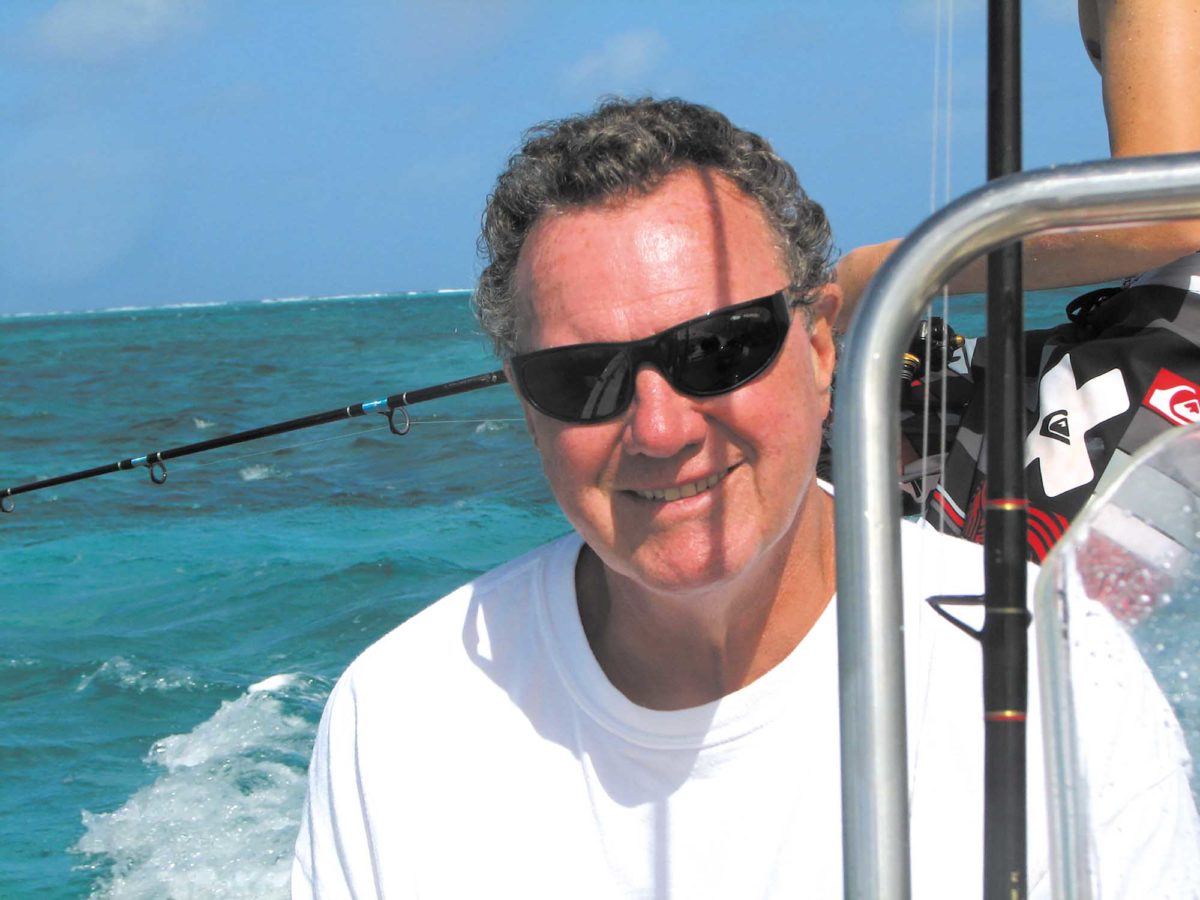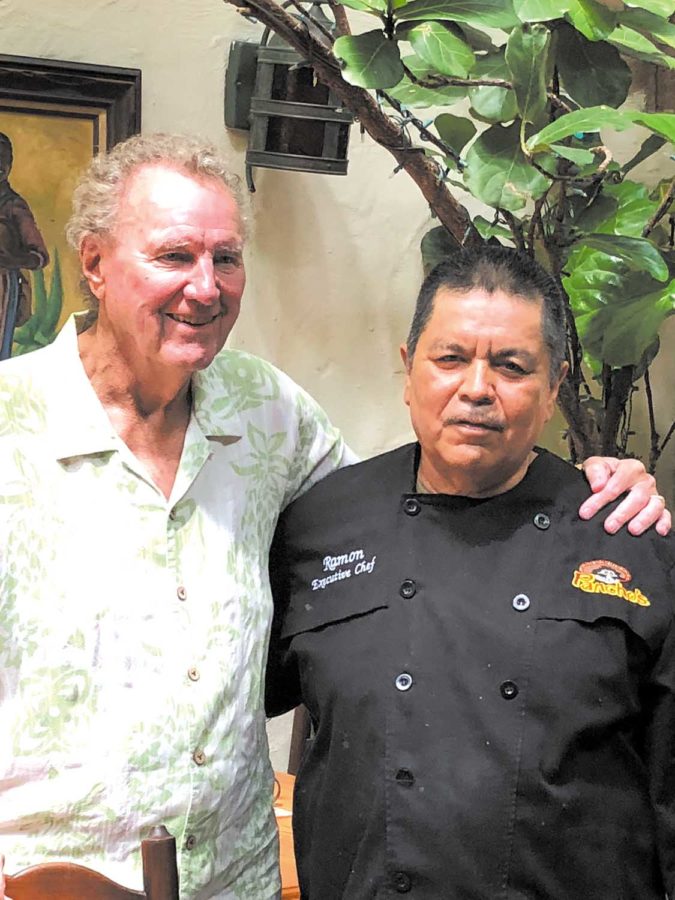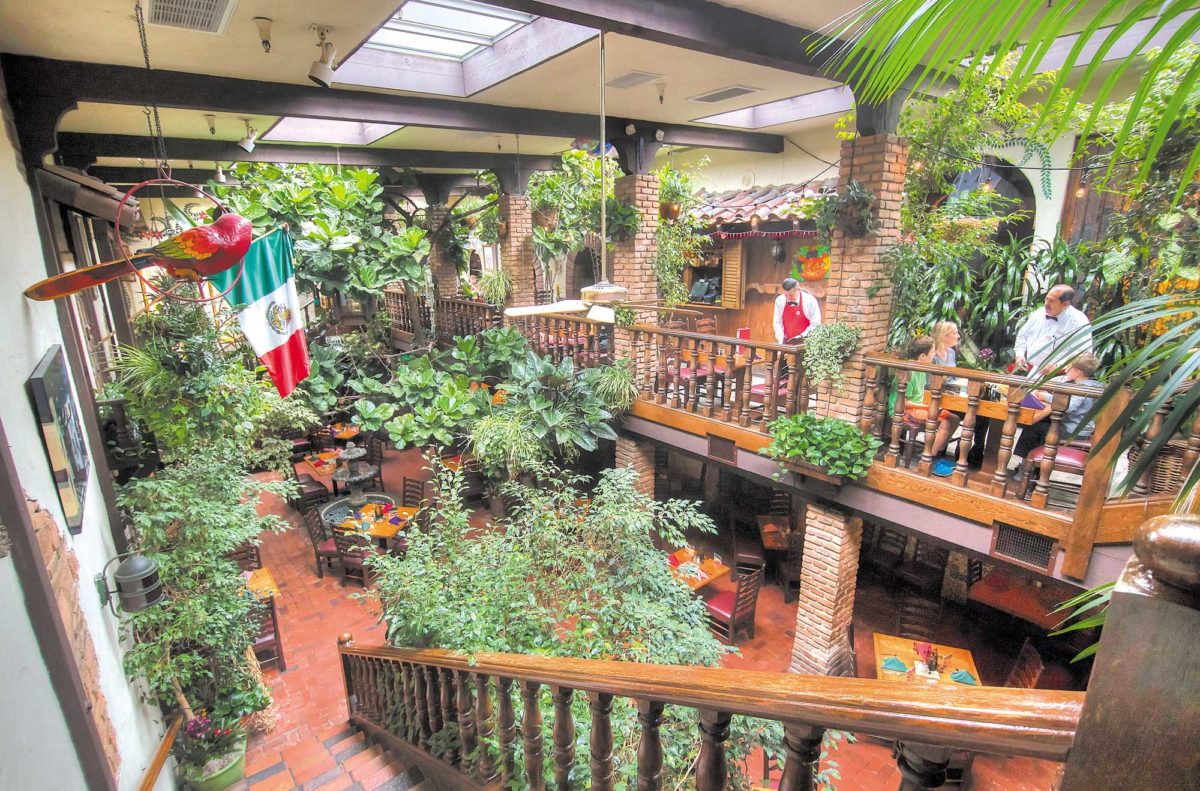The last of the great patróns

E. Abbott Lawrence, the owner of Pancho’s restaurant in Manhattan Beach, on one of his many voyages. Photo courtesy Pancho’s
The many lives of Pancho’s patriarch E. Abbott Lawrence
E. Abbott Lawrence purchased Pancho’s restaurant on the corner of Highland and Rosecrans in North Manhattan Beach in 1975. The building had already endured a storied history. It was built in 1924 as a BBQ joint and fruit stand and survived through various iterations as a general store, ice cream parlor, gambling den, and finally a cafe and restaurant. Those many lives had left Pancho’s worse for the wear.
Lawerence arrived in Manhattan Beach as somewhat of a mystery. He was tall, dark-haired, dashing and unusually well-spoken. Few knew where he’d come from. Over the next two years, he painstakingly oversaw every last detail of the transformation of Pancho’s. The hand-painted tiles had to be from Puebla de Zaragoza, Mexico. The stained-glass came from a specific East Coast antique dealer. Most importantly, when the overhaul neared completion and the restaurant prepared to reopen in 1977, he personally interviewed every employee.
His vision for Pancho’s was that it would have the look and feel of a Mexican ranch house — a hacienda — and not just on the surface. In the restaurant’s distinctive courtyard, with Mexican flag draped above its brick pillars, hidden alcoves, and thick foliage, Lawrence planted a sapling. It was as if to say: this is where roots will be planted, so a family might grow. Forty-two years later, Lawrence has left the building for the final time.
Eight years ago, he decamped to Las Vegas, where he built a second Pancho’s in the image of the first. At the end of last year, Lawrence died in Vegas, succumbing to a heart ailment. He was 79. But in Manhattan Beach, the sapling he planted is now a tree, and Pancho’s remains, run by a crew of employees that is indeed like a family — over 70 percent of the 50 employees have worked at the restaurant for more than 20 years, led by a server named Ely Villegas, who has been there since the beginning.
Bartender Felipe Gonzalez, who started as a busboy 36 years ago, recalled Lawrence’s last visit a few months ago.
“He was kind of sick, but he was happy to see me,” Gonzalez said. “I started crying because he remembered all the memories from when he was here, before moving to Vegas. He never changed.”
Gonzalez spent thousands of hours talking with Lawrence, who liked to visit the cantina and always sat in the same spot, to the left of the bar. Lawrence would begin most mornings with a glass of white wine, then maybe have a midday rum and coke, then often one of the restaurant’s signature, hand-made margaritas sometime in the afternoon. In the cantina, he befriended many of the regulars. Some would become his closest friends (and fishing companions). As the years passed, when one of those friends would pass away, their photo would go up above the bar — and not in some slapdash fashion, but carefully preserved, and well-lit. His close friends are in spots of special prominence.

E. Abbott Lawrence with Chef Ramon Hurtado, who helped found Pancho’s and worked there 40 years. Photo Courtesy Pancho’s
“He always remembered his friends,” Gonzalez said, pointing to the photos above the bar where he worked on a recent night. “Only nice people. I knew them all. This is his best friend Big Dave. This is Duffy. He started putting pictures up because his best friend passed away.”
Those afternoons in the cantina became the stuff of legends, locally. Lawerence, as he was wont to do, had hand-crafted his own, specially designed universe in the bar. A dozen large fish hang from the ceilings, to-size replicas of fish he and his family members caught. He also made that room into one of South Bay’s most treasured entertainment venues, with live music, comedy, and karaoke six nights a week.
“Ab was one of the best characters never written,” said Danno Carter, who started a popular weekly Monday night comedy show in 2013. “Anyone who visited his bar during the afternoon on a weekday can attest to that. He would get more laughs from his regulars than most of the comics get at Pancho’s Comedy Night.”
Lawrence also carefully kept track of each employee and his or her family. Most of the restaurant’s current management began by working the floor, as busboys and servers.
“In 41 years, since I come from Mexico, I have had three bosses, three patróns,” Gonzalez said. “He is the best patrón.”
“He was the sweetest person I met in this world,” said Elba Lopez, a server in Pancho’s cantina who has been an employee a mere 19 years. “He had a big heart. He always tried to help everybody, no matter who you are. No matter what you do, he always gave you the opportunity to keep going. When we have a problem, he always worries about it. He’s not just a boss, he’s family, somebody close to you. A big, big heart.”
Janice Davenport, whose job title is administrative assistant but who was essentially Lawrence’s right-hand person over the past two decades, said Lawrence was a rare combination: a successful, wealthy businessman who possessed a deep sense of humility and gratitude.
“How he approached every single employee here was as his friend,” she said. “I never left work, at the end of the day…whether he was in his office or at the bar, without him saying ‘Good night’ and ‘Thank you.’ Every single day. He appreciated people. He was totally sincere that way, and so unique. We often have some attitude about very wealthy people, but Ab wasn’t like anybody you’d ever meet. He appreciated everyone from the janitor who came in and scrubbed the floors to the people who fixed anything here. He was very grateful.”
“A lot of people don’t know this about Ab, but he was from a small town in New Jersey,” Davenport said. “His father worked in a steel factory, and his mom was a nurse. He was an only child. When he was 15 or 16, he decided he wanted to be a millionaire. And it sounds funny, but if you knew Ab, you knew he was dead serious about it, even when he was a teenager.”
Lawrence started his own family at Pancho’s. In early 1977, when he was first interviewing prospective employees, a young woman named Ann applied to be a cocktail server.
“I don’t need any more cocktail servers,” he told her. “I need a hostess.” Ann got the job and would eventually become Lawerence’s wife, and the mother of their two sons, E. Abbott Lawrence IV, and Adam, who began working in the restaurant as teenagers and now find themselves at its helm.
Davenport said that Lawrence built Pancho’s to last.
“He created this,” Davenport said. “We have older, seasoned employees working to bring younger people into managerial positions. They are all part of the family. Our manager has worked here since he was 15 or 16 years old. The focus right now is making sure all our traditions that Ab created and the nuances that he created in the business are working. And they will continue to work.”
Davenport formed a unique bond with Lawrence. As a careful, straight-laced, cost-conscious accountant, Lawrence was Davenport’s polar opposite. Though he was a shrewd businessman — Carter recalled that Lawrence took his own favorite item, roasted corn chowder, off the menu because it didn’t sell — little of what he did in life was fundamentally motivated by money. Lawrence was a lover of race tracks and owner of racehorses, an avid deep-sea fisherman who competed in professional tournaments, and a treasure hunter who pursued sunken quarry across decades and against all common sense, as far as his accountant could see. Yet in each endeavor, he would somehow prevail. He was part owner of 52 horses, with names such as King of The Roxy, which he had Davenport keep track of in a spreadsheet (with notes such as “bowed tendon,” “broken leg,” “out to breed,” “retired,” and “died”). One of his horses, whose name Davenport could not recall, raced in the Kentucky Derby. Another, Gitano Hernando, sold for an enormous sum to the treacherous former president of Chechnya, a deal consummated in Dubai.
“He said to me, ‘I want to go over there,’” Davenport recalled. “And I said, ‘Ab, please don’t go. I know you like your cocktails. This is not a good place for you to be in.’”
But two days before the opening day of races in Dubai the heavily-favored horse sold, and Lawerence took the proceeds to buy back his 77-ft. Ditmar Donaldson yacht, named Pancho’s, which he’d regretted selling to an owner who let it fall into disrepair.
The racetrack wasn’t something Lawrence did impulsively. He was a student of the sport. He read every racing publication and had a network of horse people around the world with whom he consulted. Davenport remained perplexed. “He always went to the racetrack,” she said. “Because I’m really square, I’d be like, ‘Why would anybody do that?’ ‘Why wouldn’t they?’ was his response… But he was very well-studied. He knew all the horses and their histories and what line they came from. I was like, ‘For God sakes, don’t you just dress up, go to the racetrack, and see which horse looks pretty?’”
One time he gave her a task. He was out fishing in Cabo, and told her to watch a particular race from the bar and take notes about one of the horses. The conversation that resulted was like something out of Abbott and Costello.
“How did the horse look when it came out of the gates,” he asked.
“He looked fine.”
“What do you mean ‘fine’?”
“He came out.”
“Was he bobbing his head?”
“You didn’t say to watch for that.”
“Did he move to outside, inside, or middle?”
“Well, it ran around the track.”
“Oh good grief.”
“I don’t think you should have me watch horses.”
“I know. I won’t.”
The underlying approach in the way Lawrence did everything, from restauranteering to horse racing, was highly methodical. Pancho’s is considered by many to be groundbreaking in local culinary history because it was the first restaurant to include such authentic fare as biria (a goat stew that original Pancho’s chef Ramon Hurtado transformed into a more fragrant beef stew), mole and pipian sauces. In a 30 year anniversary article Easy Reader food critic Richard Foss wrote in 2006, Lawrence described he and his staff’s ongoing quest for flavor.


The courtyard at Pancho’s, which Abe Lawrence designed, and where he planted a tree 42 years ago. Photos (CivicCouch.com)
“We do an exhaustive search – we subscribe to Mexican cooking magazines, kitchen magazines, and we try quite a number of things,” Lawrence told Foss. “Everybody here goes to Mexico several times a year, and if we taste something we like, we find the recipe and try to recreate it here.”
As Foss noted, once a prospective dish was identified and perfected, a democratic process would occur within the restaurant in which a committee composed of managers, Lawrence, and Hurtado would conduct a secret vote on whether the dish would make the menu.
“Everybody’s not going to like what I like,” Lawrence said. “For years the management and Ramon wanted to put molé on the menus, and I didn’t want it. It sells great and people like it, so I’m overruled.”
Davenport never knew what she might find Lawrence studying next. For several years, he took his family to a small island called Anegada, the very northernmost of the British Virgin Islands in the Carribean. But of course Lawrence didn’t just go for a simple vacation: he turned it into a treasure hunt. Lawrence would walk into his office to find him poring over charts, studying tides; he wanted to search for the wreckage of the HMS Astraea, a Royal Navy frigate that sank in the islands treacherous reefs in 1808. The wreckage had been discovered in 1967, but Lawrence and his sons made a project of searching the seabed in its vicinity for relics. The conditions at that reef are still considered treacherous, not an area tourists frequent.
“One trip one of the sons found an anchor,” Davenport said. “It wasn’t the main anchor, but they found this thing. His sons just had a great time. It was just so exciting.”
Lawrence likewise took crews to the famous Bisbee fishing tournament off Los Cabos, entering in the pool with professionals, which required a $30,000 entry fee. Photos of those adventures, and fishing trips to Alaska, still hang on Pancho’s walls.
“He just doesn’t do anything ‘sort of,’” Davenport said. “He does everything over the top, as far as researching, knowledge, planning, dreaming, and actually making it happen.”
Of the many lives Lawrence lived within this one, perhaps the least known was that he graduated from Princeton University, the Ivy League School, whereas a determined teenager he gained acceptance on full scholarship and played football. It was a fact of his life some of his closest friends didn’t even know.
“He would never tell anybody he went to Princeton,” Davenport said. “He was never somebody who bragged. I’d been working with him four years when one day I asked him where he went to college. He told me, and I said, ‘Wow… Most people who go to those kinds of schools…”
His look stopped Davenport in her tracks. “He just looked at me like ‘What are you talking about?’” she recalled.
In an issue of the Princeton alumni weekly published in 1990, Lawerence came as close as he ever would to bragging — about how his wife Ann caught a 170-pound halibut at Elfin Cove, Alaska, the previous August. “And she was five-and-a-half months pregnant at the time,” Lawrence told the review.
In the last year of his life, though ill, Lawrence was still looking forward to what would come next, and still improving on his present circumstances. The last time she spoke to him, Davenport said, he was researching how to find better hospital beds.
“It’s hard. I can’t believe he’s gone,” she said. “Someone larger than life can’t go.”
Carter, the comedian, said the greatest honor in his life thus far is Ab engraving his name on the Pancho’s bar.
“I miss him already. He was a great source of laughter, which is obviously what I’m always chasing,” Carter said. “Whenever I would show up at Pancho’s he’d give me a hug, buy me a beer, and ask me about how the show went that week. He had lifelong friends show up to see him every week. Watching any sport with him was like watching your favorite team with your best friend.”
Councilmember Steve Napolitano said Lawrence helped define the North End of Manhattan Beach.
“Great guy, great friend to Manhattan Beach, and an icon of the North End,” Napolitano said. “Very sad loss, but glad to know his legacy will endure through his family.”
Of all the unlikely tricks that Lawrence pulled off in his seven decades, Davenport keeps circling back to the one that surrounds her and the Pancho’s crew every day of their lives. He made them all feel loved.
“He called his own shots, built his own business, and put in his own style. He wouldn’t call it style, but ‘This is just how you do it,’” she said. “The reason this restaurant has been here so long is because of his respect for employees. He got 100 percent out of every one of us. You wanted to make him happy and please him, because it was a win-win situation. To have 50 plus employees all feel valued, all feel like he gave a shit about us — just amazing. He was the most amazing person I ever met.”
“Ab was the big dog, and he didn’t run in the pack. Everyone wanted to follow him, wherever he went.”

